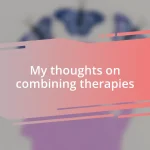Key takeaways:
- Nerve block therapy involves targeted injections of anesthetic or anti-inflammatory medication to manage pain effectively and improve quality of life for individuals with chronic pain conditions.
- The procedure is straightforward, using imaging guidance to accurately inject local anesthetics near specific nerves, resulting in varying levels of pain relief and enhanced mobility.
- Recovery from nerve blocks requires patience, gentle routines, and self-awareness to track progress and navigate heightened sensations, ultimately leading to significant improvements in well-being.

Introduction to nerve block therapy
Nerve block therapy is a fascinating and effective approach used to manage pain by targeting specific nerves directly. I remember the first time I learned about this technique—my curiosity sparked as I heard how it provided relief for patients suffering from chronic pain conditions. It made me wonder: could this be a solution for those who felt trapped by their discomfort?
Essentially, nerve blocks involve the injection of anesthetic or anti-inflammatory medication near targeted nerves. I recall speaking with a friend who underwent this therapy for her debilitating migraines. She described her sense of freedom afterward, how a world of possibility opened up when the pain subsided. This personal testimony illustrates how nerve block therapy can change lives by providing relief that many would consider unattainable.
As I delved deeper into the intricacies of the procedure, I became increasingly fascinated by its versatility. From managing pain post-surgery to alleviating discomfort from conditions like arthritis, nerve blocks can be tailored to meet individual needs. Isn’t it incredible how a simple injection can make such a significant difference? In my experience, this approach empowered my understanding of pain management and the potential for improved quality of life.

The nerve block procedure explained
The nerve block procedure is quite straightforward yet remarkably effective. During the process, a healthcare professional identifies the specific nerve that needs attention. I remember feeling a mix of excitement and nervousness when I first observed this procedure being done; the precision required in locating the nerve left a lasting impression on me.
Once the target nerve is pinpointed, a local anesthetic is injected, often using imaging guidance to enhance accuracy. I witnessed the relief wash over a patient when the injection took effect—it was almost like watching a heavy burden detach from them, allowing them to breathe easier and move with newfound freedom. In that moment, I understood just how transformative this simple act could be.
Post-procedure, patients typically experience varying levels of pain relief, which can last from hours to months depending on the individual and the specific condition being treated. I find it fascinating how some individuals may even find an improved sense of mobility and overall quality of life, transforming their day-to-day experiences profoundly. Isn’t it amazing how unlocking a nerve can unlock potential otherwise constrained by pain?
| Aspect | Description |
|---|---|
| Procedure Type | Interventional |
| Target | Specific nerves |
| Medication Used | Anesthetic or anti-inflammatory |
| Outcome | Pain relief and improved mobility |

Managing recovery after nerve blocks
Managing recovery after receiving nerve blocks can be a transformative experience, and it often varies significantly from person to person. Personally, I found that paying attention to my body during this time was crucial. Initially, I experienced a wave of relief, but I also had to navigate some residual discomfort as the effects of the anesthetic wore off. It struck me how acute awareness of my sensations helped me better communicate my needs with my healthcare provider.
During recovery, it’s important to establish a gentle routine. I remember when I started incorporating light stretching and mobility exercises into my day. These simple movements not only helped ease any stiffness but also reminded me of the freedom I was beginning to regain. Have you ever noticed how much little actions can contribute to a heightened sense of well-being? Acknowledging these small victories kept my spirits high throughout the recovery process.
I also learned that patience is key. Nerve blocks can offer significant pain relief, but for me, the full benefits took time to materialize. I found solace in journaling my progress, which allowed me to reflect on both the good days and the not-so-great ones. It was empowering to see my journey unfold, reminding me that recovery isn’t always linear but rather a series of steps, each leading me closer to reclaiming my life from pain.













